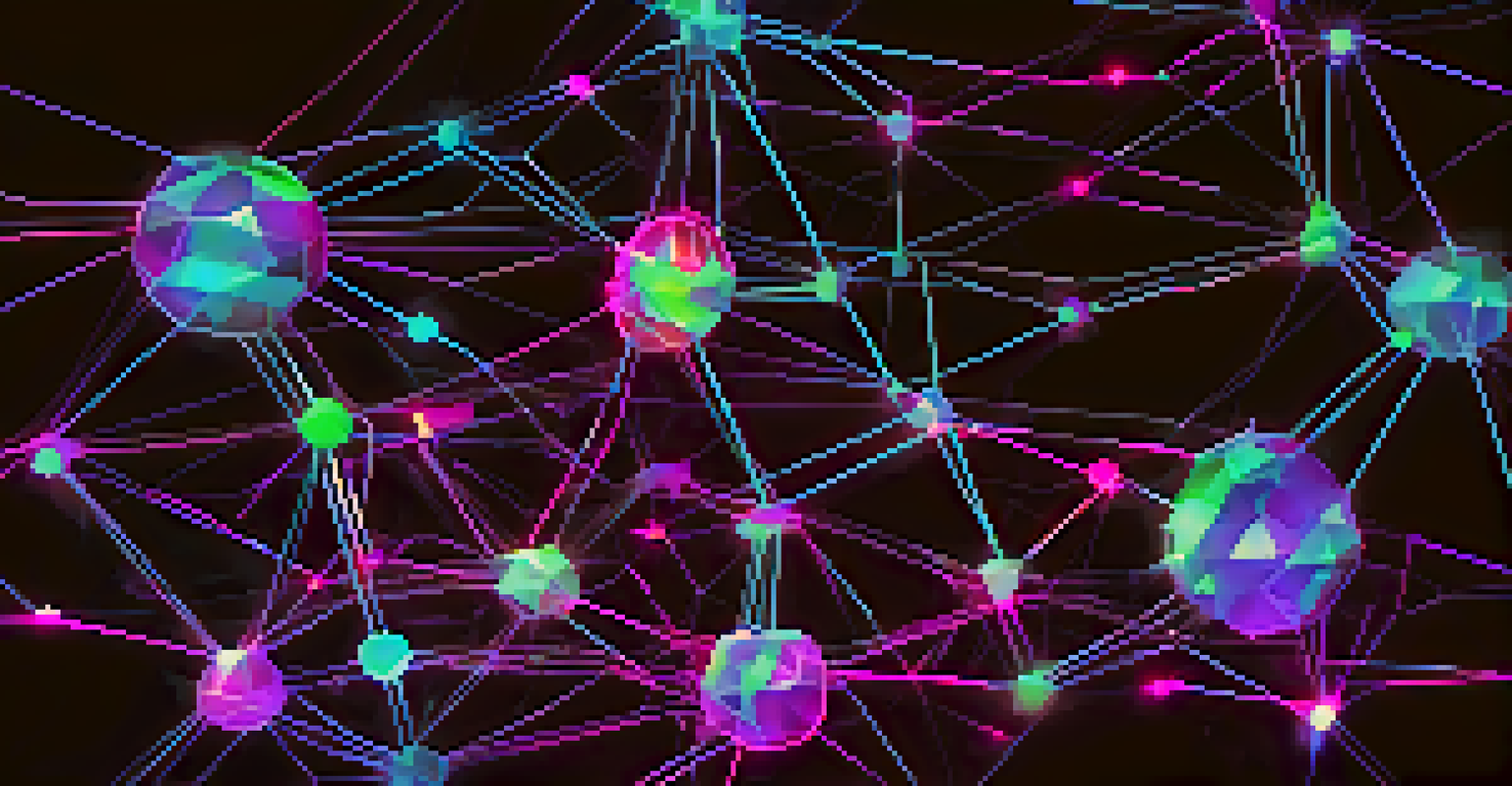Interoperability Challenges Between NFTs and DeFi Networks

Understanding NFTs and DeFi: A Quick Overview
Non-Fungible Tokens (NFTs) and Decentralized Finance (DeFi) are two revolutionary concepts in the blockchain world. NFTs represent unique digital assets, while DeFi encompasses financial services utilizing blockchain technology without intermediaries. Together, they promise to reshape the digital economy, but their integration poses several challenges.
Interoperability is the key to unlocking the full potential of blockchain technology.
Both NFTs and DeFi operate on blockchains, yet they serve different purposes and functionalities. NFTs are often tied to art, collectibles, and ownership proofs, while DeFi focuses on lending, trading, and yield farming. Understanding these distinctions is crucial for addressing interoperability issues.
As the digital landscape evolves, bridging these two domains could unlock new opportunities. However, it’s essential to recognize the specific challenges each sector faces to pave the way for smoother integration.
The Importance of Interoperability in Blockchain Ecosystems
Interoperability refers to the ability of different blockchain networks to communicate and work together seamlessly. In the context of NFTs and DeFi, this means enabling NFT-based assets to be utilized within DeFi platforms. The potential benefits include enhanced liquidity, broader access to financial products, and greater utility for NFTs.

Imagine a world where you could use your digital artwork as collateral for a loan or stake your collectibles for earning interest. That’s the promise of interoperability, but achieving it requires addressing several technical and regulatory hurdles.
Interoperability is Key for NFTs & DeFi
Bridging NFTs and DeFi requires overcoming technical and regulatory challenges to enhance liquidity and utility.
Without interoperability, both NFTs and DeFi risk becoming isolated ecosystems, limiting their growth potential. As the demand for integrated solutions rises, the need for effective interoperability strategies becomes increasingly vital.
Technical Challenges in Connecting NFTs to DeFi
One of the primary technical challenges is the differing standards used by NFT and DeFi platforms. For instance, NFTs often follow the ERC-721 or ERC-1155 standards on Ethereum, while DeFi protocols may use ERC-20 tokens. This discrepancy complicates the development of cross-platform tools and services.
In a world increasingly driven by digital assets, understanding the interconnectedness of NFTs and DeFi is essential for innovation.
Additionally, smart contracts—the backbone of both NFTs and DeFi—must be able to interact with one another. However, creating smart contracts that can seamlessly handle both fungible and non-fungible assets requires complex coding and a deep understanding of both domains.
Lastly, scalability issues can arise when attempting to process transactions across multiple networks. High transaction fees and slow processing times can hinder the efficiency of interoperability solutions, making it essential to tackle these technical barriers head-on.
Regulatory Hurdles Affecting NFT and DeFi Integration
Regulatory uncertainty is another significant challenge in the interoperability landscape. Different jurisdictions have varying rules regarding NFTs and DeFi, which can complicate the development of universal standards. This inconsistency can deter developers and investors from fully engaging with cross-platform solutions.
For example, some countries classify NFTs as securities, leading to stringent compliance requirements, while others view them differently. This lack of a cohesive regulatory framework creates confusion and inhibits innovation in the space.
User Experience Impacts Adoption
Simplifying the onboarding process and creating intuitive interfaces are crucial for user engagement in NFT and DeFi platforms.
Navigating these regulations is crucial for fostering a conducive environment for interoperability. As the industry matures, clearer guidelines will be essential in bridging the gap between NFTs and DeFi.
User Experience Challenges in NFT and DeFi Interactions
User experience plays a critical role in the adoption of any technology, and this is especially true for NFTs and DeFi. Many users find the process of connecting their NFTs to DeFi platforms confusing and cumbersome. This complexity can lead to frustration and deter users from exploring these integrated solutions.
Furthermore, the technical knowledge required to navigate the platforms can be a barrier for the average user. Simplifying the onboarding process and creating intuitive interfaces are vital steps toward enhancing user experience and promoting interoperability.
By addressing these user experience challenges, developers can create more accessible platforms that encourage wider participation in the NFT and DeFi ecosystems.
Potential Solutions for Enhancing Interoperability
To tackle the interoperability challenges between NFTs and DeFi, several innovative solutions are being explored. One approach is the development of cross-chain bridges that allow assets to move freely between different blockchain networks. These bridges can facilitate the use of NFTs in DeFi applications, enhancing their liquidity and utility.
Another potential solution lies in the standardization of protocols. By creating universal standards for NFTs that can be recognized across various DeFi platforms, developers can simplify the integration process and enhance compatibility between the two ecosystems.
Innovative Solutions for Integration
Cross-chain bridges and standardized protocols are essential for fostering interoperability between NFTs and DeFi.
Collaboration among developers, regulators, and users is also essential to drive innovation in this space. By working together, stakeholders can create a more cohesive framework for interoperability, ultimately benefiting the entire blockchain ecosystem.
The Future of NFTs and DeFi: A Unified Ecosystem?
Looking ahead, the potential for a unified ecosystem where NFTs and DeFi coexist harmoniously is exciting. If the challenges can be addressed effectively, we could witness a surge in innovative financial products and services that leverage the unique characteristics of both NFTs and DeFi.
This future may include new financial instruments that incorporate NFTs, such as NFT-backed loans or fractional ownership models. Such developments could democratize access to valuable digital assets, creating a more inclusive financial landscape.

Ultimately, the journey toward interoperability between NFTs and DeFi is a collaborative effort. By embracing creativity and innovation, the blockchain community can build a more interconnected and dynamic digital economy.